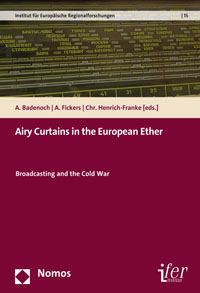Band 15: Airy Curtains in the European Ether

A. Badenoch | A. Fickers | Chr. Henrich-Franke [eds.]
Airy Curtains in the European Ether.Broadcasting and the Cold War.
Airy Curtains in the European Ether: Introduction [extract]
Alexander Badenoch/ Andreas Fickers/ Christian Henrich-Franke
In a key scene in Wolfgang Becker’s well-known 2003 film Goodbye, Lenin!, the protagonist Alex sits in an apartment in West Berlin with his half-siblings, watching the East German Sandmännchen (little sandman), the puppet character that was a key part of the bedtime ritual on East German television since 1959. Most German viewers of the film were well aware that there was also a West German Sandmännchen in a similar role and time slot, and the scene served in part as a moment of hope in what Eric Rentschler calls the “Postwall Cinema of Consensus” where the two sides would eventually be able to appreciate each other’s experience. In fact, anthropologist Daphne Berdahl noted that, if asked, “there are few Eastern Germans who will not mention with pride that ‘our’ sandman prevailed.” While the divided sandmen point to a cultural overlap (and indeed dialogue of sorts) in the film and the memories that surround it, the East German sandman is one more piece of “insider knowledge” that supports a popular understanding of both a country and a continent as fundamentally isolated spaces of communication. Without wanting to dispute directly the experience of isolation, such memories might have been complicated had Alex discovered that a number of the Eastern children’s programmes he knew were also popular in much of Western Europe.
During the Cold War, the mental model of two separate communication blocs was prevalent, but not without its challenges. When the European Broadcasting Union (EBU), the federation of (then) Western broadcasters, was preparing new plans for exchange of news via satellite in the closing years of the Cold War, it drew up a glossy folder with a portrayal on its cover of the satellite’s footprint. The footprint of the satellite ECS II was of course not so easily contained by national borders, so to avoid any misunderstandings, the makers of the pamphlet carefully blacked out the territories of their neighbours in the Organisation Internationale de Radiodiffusion et Télévision (OIRT) to the East (map 1). While it did reflect the aims of the satellite service, this polite political gesture belied the fact that the two organizations had been news and sport coverage between their terrestrial networks since 1960.
These are just two short examples among a number of complex and often contradictory ways in which broadcasting both united and divided the Cold War blocs. Both show that while ideological antagonism and attempted isolation were indeed key dynamics that marked these relationships between 1945 and 1990, they were also accompanied by processes of communication and co-operation. It is a mental commonplace that electromagnetic waves cross borders as lightly as if they were made of air, but if we look more closely, broadcasting is no more or less ‘solid’ than the interwoven sets of material, institutional and symbolic regimes that demarcate national boundares. We need to grasp the contradictory dynamics of both if we are to understanding broadcasting in the Cold War.
